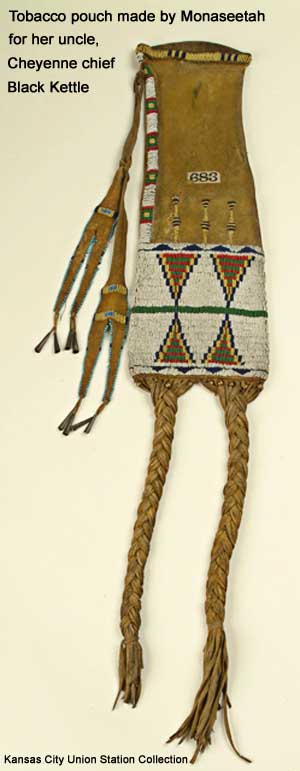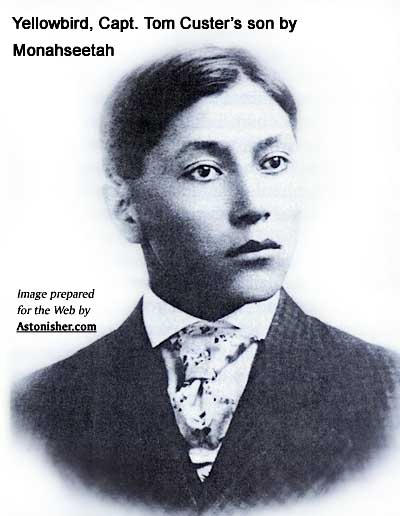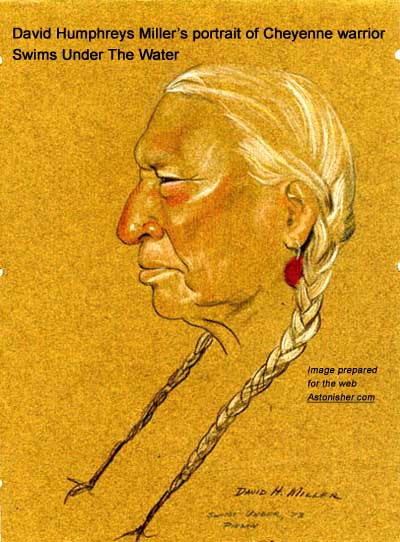|
||||||||||||
Bruce Brown's 100 Voices... Brave Bear's Story of the Battle, #2
BRAVE BEAR'S STORY OF THE BATTLE NOT FAR from Two Moon's lodge was the tribal medicine tepee which contained the sacred Buffalo Head of the Northern Cheyennes -- corresponding to the Buffalo Calf Pipe of the Sioux as a revered object. Like all the camps, the lodges were pitched in a great circle open to the east. The medicine tepee was along the western edge of the wide space within the circle, directly across from this gap. Guarding the sacred lodge was Roan Bear, a Fox warrior. Cheyenne fighting men on the Little Big Horn were divided into three warrior societies: Elk warriors, Crazy Head warriors, and Fox warriors. At this time, the Fox warriors were on duty as camp policemen. It was up to them to enforce tribal laws -- of which the Cheyennes had many --and to watch for the approach of enemies. The Sioux had a similar system. While serving as guard for the medicine lodge, Roan Bear was permitted to talk to other warriors. Visiting him at midmorning were Bobtail Horse, an Elk warrior, and an Ogalala Sioux named White Cow Bull. The Ogalalas, as well as other tribes, had been invited to attend the Cheyenne scalp dance that night. White Cow Bull had ridden over to spend the day visiting friends in the Cheyenne camp. Other visitors included a small contingent of Southern Cheyennes. Their chief was Lame White Man, aged thirty-eight, who had lived with the northern branch of the tribe so long he was no longer considered a southerner. Visiting him were eight Southern Cheyenne warriors and their families, led by thirty-one-year-old Brave Bear. They stayed in one big lodge next to Lame White Man's. With the Rosebud fight fresh in their minds, Brave Bear talked to Lame White Man this morning of the dread winter eight years ago on the Washita River far to the south. At that time soldiers [led by George Custer] had come to destroy Black Kettle's band of Southern Cheyennes. There had been no warning of the surprise dawn attack. A hail of bullets had greeted Black Kettle's futile attempt to parley with the soldiers. A few warriors got away, finally; but Black Kettle lay dead, and the women and children of the tribe were led away into captivity at far-off Camp Supply on the North Fork of the Canadian River.
"She was a proud woman," Brave Bear told Lame White Man. "For long months she kept silent as the child of the soldier-chief grew within her womb. At last, when the Cheyennes were all together again and the soldier-chief was talking peace with us, Monahseetah told him she was happy to bear his child. After that, he shunned her as though she had the white man's dreaded spotted sickness (smallpox). "It was then that we chiefs met with this soldier-chief and smoked the pipe with him, for by now we were all ready for peace. The soldier-chief solemnly promised he would never attack us or fight us again. Someone explained to him that our smoking with him made the peace promise binding on us as well. The pipe was in my charge that day. It was my honor to light it first and smoke it last. Looking about me, I saw from their faces that the hearts of the Southern Cheyenne leaders were warm with hope. For a moment I, too, felt warm toward the soldier-chief and all white men. Then my mind darkened with thoughts of Monahseetah's disgrace. I took the dead ashes from the pipe and spilled them on the boots of the soldier-chief, placing upon him the endless curse of the Everywhere Spirit." Brave Bear broke off suddenly as a gangling boy of seven with light streaks showing in his lank hair crept through the oval flap of the big tepee and stood blinking in the morning sun. A moment later a young woman whose face was still fair to look upon followed. At the woman's silent touch, the boy turned away to accompany her toward the river, where they went each day to gather kindling for the breakfast cookfire. Lame White Man waited until they were out of earshot before he spoke.
Brave Bear signed yes. "He goes with her everywhere, not caring to be around full-blooded children. Yet only his hair shows pale streaks, the light color such as white men often have. Otherwise, he could well be one of us." Lame White Man signed agreement. For a while he remained quiet, for he wondered how his own wife might react if he told he was thinking of taking a second wife-and that he was considering Monahseetah, whose name was darkened by a cloud of white conquest eight years ago. At last he asked a question of Brave Bear. "Yellow Bird was fathered by the white soldier-chief ?" "It is so," Brave Bear answered. "The soldier-chief who had yellow locks hanging to his shoulders, the one we all called Long Hair." Custer's Fall: The Indian Side of the Story by David Humphreys Miller, University of Nebraska Press, Lincoln, NE 1957 p 63 - 65
Although Brave Bear asserted that George Custer fathered Monaseetah's child, Yellow Bird, it is more likely that the actual father was George's brother, Thomas Custer, due to the fact that the gonorrhea that George A. purportedly contracted at West Point apparently left him sterile and therefore incapable of fathering child. "He was shooting blanks," cackled one old soldier. * * * Brave Bear was a Southern Cheyenne who joined the Northern Cheyenne after the defeat of the Dog Soldiers at Summit Springs in 1869. He was present when General George Crook attacked Dull Knife's village in 1876, shortly before the Little Bighorn, and lost a son in that engagement. Brave Bear is one of several warriors sometimes named as the man who killed Custer, based on his description of the killing an officer on a sorrel horse at the very end of the Custer fight. In fact, Brave Bear was voted the honorary title of The Man Who Killed Custer at the Rodman Wanamaker -sponsored last Great Council on the Little Bighorn in 1909. However, based on both the eye-witness accounts of the battle and the subsequent developments on the battlefield that day, it appears that Custer was killed or seriously wounded at the very outset of the Custer Fight, probably by White Cow Bull at the river before Custer's troops were fully engaged in the battle. Later, in the confusion of the final moments of the battle, it is impossible to say who may have been riding a sorrel horse. See Astonisher.com's Who Killed Custer -- Top Ten List for more info. * * *
Miller frequenlty made pastel sketches of the Sioux survivors of the Battle of the Little Bighorn whom he interviewed. Some of Miller's portraits are exceptionally fine evocations of the historic personalities in their own right, such as his portraits of Lazy White Bull and Old Eagle and Black Elk late in life. Click here for information of David Humphreys Miller's sources among the Sioux, Cheyenne, Crow, Arikara and Apapaho. * * * Here is another account of the battle by Brave Bear. Here is Dives Backward et al's recollection of Monaseetah. -- Bruce Brown
|
||||||||||||






 "The boy with Monahseetah now -- the lad called Yellow Bird -- he is the son of the soldier-chief who killed Black Kettle?"
"The boy with Monahseetah now -- the lad called Yellow Bird -- he is the son of the soldier-chief who killed Black Kettle?" Although not born into the Teton Sioux, David Humphreys Miller was adopted late in life by both
Although not born into the Teton Sioux, David Humphreys Miller was adopted late in life by both 







